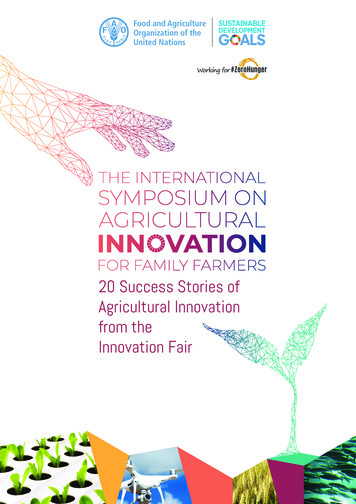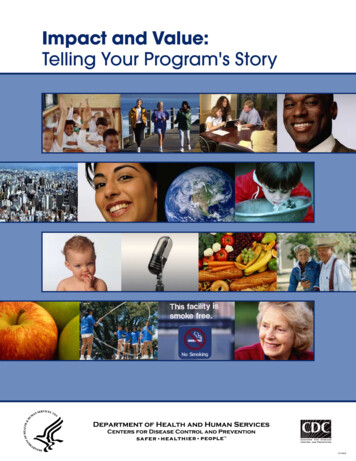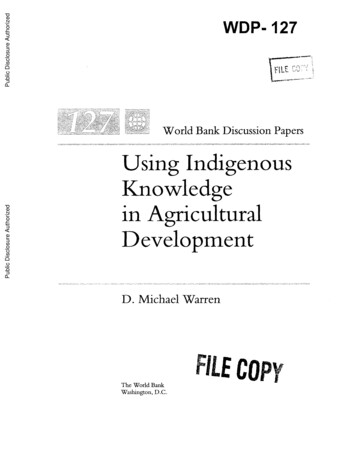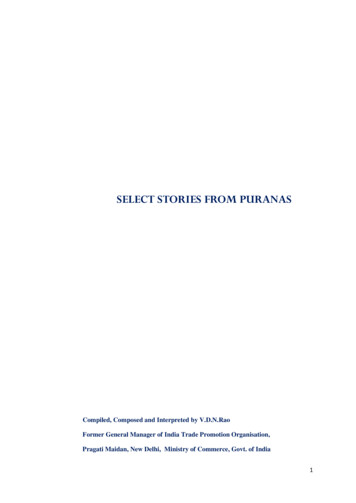
Transcription
20 Success Stories ofAgricultural Innovationfrom theInnovation Fair
PREFACEOne of the objectives of The International Symposium onAgricultural Innovation for Family Farmers: Unlocking the potentialof agricultural innovation to achieve the Sustainable DevelopmentGoals, held at the Food and Agriculture Organization of the UnitedNations (FAO) Headquarters in Rome, 21-23 November 2018, wasto celebrate inspiring success stories of innovation and innovators.One of the ways to do this was through an Innovation Fair, whichshowcased the 20 success stories gathered in this booklet ofagricultural innovation for family farmers and/or by family farmers.that had to be faced and overcome before the innovations werebrought into use. The cases show the impact that these agriculturalinnovations have made in people’s lives.The Innovation Fair explored how and why agricultural innovationhappens and benefits family farmers. This booklet, in the same wayas the Fair, aims to increase the understanding of innovation inagriculture and its key role to achieve the Sustainable DevelopmentGoals.The selection of success stories presented at the Innovation Fairaimed to encompass and capture a broad range of innovations thatare being used in the different agricultural sectors (crop, livestock,fisheries and aquaculture, forestry). Most of them came from acall for FAO staff to propose successful examples of agriculturalinnovation based on their wide experience and knowledge indifferent fields of expertise and regions. The majority of thoseselected were not from FAO’s work.During the Fair, each success story had a presenter and a dedicatedspace in the FAO Atrium. Presenters were available to discuss withparticipants about their innovation and success story. They talkedin an informal way about the constraints they faced, as well as thedrivers that led to innovation and success. FAO/Alessia PierdomenicoFor that purpose, success stories presented in the Fair provideexcellent examples of the key drivers that lead to successfulinnovation, without neglecting the obstacles and challenges2
FAO/Alessia PierdomenicoThe definition of agricultural innovation that FAO used for theSymposium is: “Agricultural innovation is the process wherebyindividuals or organisations bring new or existing products,processes or ways of organisation into use for the first time in aspecific context in order to increase effectiveness, competitiveness,resilience to shocks or environmental sustainability and therebycontribute to food security and nutrition, economic development orsustainable natural resource management”.The success stories revolve around the use of agricultural innovationto address four key challenges : climate change; sustainable naturalresource management; food insecurity, hunger and malnutrition; andjob creation, with a focus on youth.Preparation of this booklet was led by FAO’s Office for CorporateCommunication, with support from the Symposium Secretariatand the Innovation Fair presenters. The name and affiliation of theInnovation Fair presenters are provided at the end of each story.Novelty is a key aspect of the definition, i.e. although the products,processes and ways of organisation may already exist, theyare new to the individuals or organisations who are bringingthem into use in a given location and context for the first time.Also, it is not restricted to use of technologies but also use ofsocial, organisational, institutional or marketing processes orarrangements. Further details on the definition are available nnovation-familyfarmers-symposium/about/faq/en/All in all, this booklet aims to replicate to a certain degree whatthe Innovation Fair represented, i.e. a unique space to explore keyquestions and issues of agricultural innovation around the world.3
GROWING FOOD IN IMPOSSIBLE PLACESHOW ADAPTED HYDROPONIC SOLUTIONS HELP COMMUNITIESTO STRENGHTEN LIVELIHOODS BY GROWING FOOD ANYWHERETHE SITUATIONSahrawi refugees and their descendants have inhabited refugeecamps in the Algerian Saharan desert for over 40 years, theconsequence of a protracted refugee crisis. In these areas,temperatures often soar to 50 degrees Celsius, water is scarce andthere is limited availability of grazing lands. Nina SchröderTraditionally nomads, the Sahrawi raise livestock as part of theirlivelihoods. Animal products are an essential part of their diet butbecause there is limited fodder to feed their goats and sheep, theseanimals usually end up eating leftovers and rubbish, leading to poorquantity and quality of meat and milk available.THE DRIVERSTaleb, a Sahrawi refugee with an agricultural engineeringbackground, in 2016, came up with the idea of testing thehydroponic technique in the refugee camps, as any other traditionalagriculture method was not possible in arid desert areas. The WorldFood Programme Innovation Accelerator helped the refugees todevelop a localized low-tech hydroponic unit that could be sourcedand managed locally to grow barley fodder for their animals.THE CHALLENGESExtreme weather and scarcity of water are a constant challenge forhouseholds to grow crops year-round and provide for their familiesand livestock. In local markets, vegetables and fodder are either notavailable or not affordable.THE INNOVATIONLow-tech hydroponics enable plant growth in arid environmentswith a soilless cultivation technique. It is a livelihood-smart andcost-efficient solution that uses up to 90 percent less water and 75percent less space. With the H2Grow project, the Sahrawi refugeesin the Algerian Sahara desert have tested and adapted a high-techhydroponic system to a sustainable low-tech, locally producedhydroponic unit, which provides fodder supply for their livestockyear round. In 2018, the H2Grow project has also started with a localadaptation in Eastern Chad, in the Sudanese refugee camps and itis also being piloted in Internally Displaced People (IDP) camps inDarfur, Sudan, in collaboration with FAO.The H2Grow project is continuously exploring different solutionsto overcome these challenges, also by leveraging its partnershipswith FAO, governments, academia, NGOs such as OXFAM, andthe communities to develop and deploy the most adapted andaffordable solution to every context, considering local constraintsand limitations.THE IMPACTH2Grow is now being implemented in 9 countries - Peru, Algeria,Jordan, Chad, Sudan, Kenya, Namibia, Mali and Niger - reaching5000 people amongst refugees, IDPs and urban communities livingin vulnerable areas, of which 75 percent are female participants. Nina SchröderFrom sprouting green fodder in deserts to fresh vegetables in urbanslums, with H2Grow, communities are growing food in impossibleplaces and strengthening their livelihood with new options of lowcost dietary diversity and expanded sources of income.4INNOVATION FAIR PRESENTER: Nina Schröder, Co-Founder H2Grow/Scale-up Enablement Manager, United Nations World FoodProgramme (WFP), WFP Innovation Accelerator, Munich, Germany
A-MAIZE-ING!SWITCHING TO DROUGHT-TOLERANT MAIZE GIVES ZIMBABWEAN FARMERSA BOOST IN FOOD SECURITYTHE SITUATIONFormerly a prosperous, self-sufficient agricultural producer,Zimbabwe’s erratic rainfall in recent years has posed a huge limitingfactor for millions of farming households who depend on maizefor food security and their economic well-being. Since the early1990s, drought stress has steadily decreased the production andproductivity of maize in Zimbabwe, changing the country’s role froma surplus producer of maize to a net food importer, and plungingmillions of rural communities into food insecurity and poverty.THE DRIVERS CIMMYTSince the turn of the century, most farmers in southern Africaexperienced around one to three drought years, due to climatechange. In Zimbabwe, the situation was far worse with farmersreporting four to five years of drought in the same period.THE CHALLENGESIn response, the country turned to the International Maize andWheat Improvement Center (CIMMYT) to develop new maizevarieties that could withstand drought conditions. By switching tothese drought-tolerant maize varieties, Zimbabwean smallholderfarmers could dramatically increase their yields and in so doing,save their lives and livelihoods.Initially, the introduction of drought-tolerant maize was low. Farmerswere sceptical that these new varieties would deliver on theirpromise and were reluctant to invest and risk the whole crop failing.It was only through demonstrations where farmers could comparethe yields of the new varieties with those commonly grown thatdemand for drought-tolerant seeds was generated.THE INNOVATIONWith the International Institute of Tropical Agriculture (IITA),CIMMYT piloted the Drought Tolerant Maize for Africa (DTMA)project to breed drought-tolerant maize varieties for the regionand particularly for Zimbabwe. The project involved the nationalmaize breeding programmes of 13 sub-saharan African countriesand private seed companies. Between 2007 and 2013, around 160drought-tolerant maize varieties were released and scaled up foruptake by smallholder farmers, 15 of them in Zimbabwe.Seed companies were also reluctant to scale up and marketdrought-tolerant varieties because they were unaware that thesevarieties grew equally well under rainy season. Extension agentsrequired training on how to promote the advantages and use ofthese varieties to farmers in drought prone areas.THE IMPACTFor the same amount of seeds, farmers who grew drought-tolerantmaize varieties were able to harvest over 600 kg more maize perhectare, compared to those using drought-susceptible varieties.The additional maize translated to US 240 extra per hectare, givingfarmers a buffer of nine months’ worth of additional food securityat no additional cost as well as extra income for other householdneeds. CIMMYTMillions of farmers in the region benefited from the outputs of thispartnership, which included support and training for African seedproducers and the promotion of vibrant, competitive seed markets.5INNOVATION FAIR PRESENTER: Cosmos Magorokosho, InternationalWheat and Maize Improvement Centre (CIMMYT) Southern AfricaRegional Office, Harare, Zimbabwe
OUTSMARTING THE WEATHERHOW WEST AFRICA’S CLIMATE-SMART VILLAGES ARE MITIGATING THEEFFECTS OF CLIMATE CHANGETHE SITUATION Mathieu OuedraogoWest Africa is blessed with an abundance of natural and humanresources, yet remains one of the poorest regions on the planet. Theagriculture sector in this region has been severely inhibited owingto climate change in recent years. Extreme climate events, such astorrential rain followed by extensive droughts, strip the soil of itsnutrients, and negatively impact its fertility and its ability to growcrops. Innovations in agriculture are therefore key to conserving theworld’s biodiversity and to ensuring the ability of millions of smallfarmers to grow their own food.THE DRIVERSThe reason why agricultural innovations often fail in countriesis because they cannot be up scaled either appropriately oreffectively. Not so with climate-smart villages (CSVs) as they canbe implemented effectively with positive long-term results for cropproduction, which makes them so attractive.THE INNOVATIONTHE IMPACTThe CSV is an approach where research, extension, NGOs andothers partners (public and private sectors) actively participate incross-cutting testing to validate technological and institutionaloptions to address the effects of climate change in agriculture.CSVs implement sustainable technologies and practices, such asimproved varieties of crops, soil and water conservation techniques,for example, zaï, half-moon, tied ridging, agroforestry such as treeplanting and farmer managed natural regeneration, and integratedsoil fertility management using organic manure or crop association.Once proven, the options are then scaled up, drawing lessons forpolicy makers from local to global scale.The CSV approach has proven effective as a scalable partnershipbetween rural communities and broader stakeholders, with greatpotential to be deployed and implemented in similar environments.Food security has improved through the use of organic manure/compost, soil and water conservation techniques such as tiedridging and zaï. Farmers managed natural regeneration andintegrated soil fertility management (micro-dosing, crop associationand crop rotation) in Burkina Faso, Ghana, Mali, Niger and Senegal.The CGIAR Research Program on Climate Change, Agriculture andFood Security (CCAFS) has been working since 2011 with localpartners to develop CSVs. Since 2015, the concept of CSVs has beenembraced by researchers, extension and NGO agents alike. TheWorld Bank now have CSVs at the heart of its project in Niger. In2017, CSVs was adopted by the Saskawa Africa Association in Maliand Nigeria.THE CHALLENGESNot all the components of the CSV model have been easy toimplement. Components that were particularly challengingare climate information services and insurance, national andsubnational plans and policies, climate and ag-developmentfinances, and local and national public and private institutions.More training to develop the capacity of partners (NARS, NGOs,etc.) to implement the CSV approach is also needed.Women farmers’ income have improved through the developmentof gender sensitive activities including off-season gardening andprocessing of non-timber forest products in Senegal, moringa treeplanting in Niger and Burkina Faso, sesame cropping in Mali andsoybean production in Ghana.From the farmers’ side, the main constraints they reported inadopting climate-smart agriculture (CSA) technologies and practiceshave been the limited availability and accessibility of inputs, thepoor technical capacity due mainly to the illiteracy of farmers and,finally, the low financial capacity of farmers.INNOVATION FAIR PRESENTER: Mathieu Ouedraogo, SeniorScientist, CGIAR Research Program on Climate Change, Agricultureand Food Security (CCAFS), International Crops Research Institutefor the Semi-Arid Tropics, West and Central Africa (ICRISAT-WCA),Bamako, Mali.6
PEST CONTROL ON THE FLYA MOBILE APP FOR MONITORING AND EARLY DETECTION OF THE DESERTLOCUST IN AFRICA AND ASIATHE SITUATION Keith CressmanThe Desert Locust is considered to be the most dangerous of allmigratory pest species in the world due to its ability to reproducerapidly, migrate long distances and devastate crops. This is becausethe pest has the ability to change its behaviour and physiology, inparticular its appearance, in response to environmental conditions.It can transform itself from a harmless and solitary individual to partof a collective mass of insects that form a cohesive swarm, whichcan cross continents and seas, and quickly devour a farmer’s fieldand his entire livelihood in a single morning.THE DRIVERSAs part of the FAO work in emergencies, member countries andstakeholders requested the Organization to establish a monitoringand early warning system for the Desert Locust in Africa and Asia toallow governments to manage this deadly pest effectively.This allows FAO to provide countries with more timely and preciseforecasts and warnings to better manage Desert Locusts.THE INNOVATIONTHE CHALLENGESFAO developed eLocust3, a rugged tablet used by national surveyand control teams in 30 countries to record and transmit, viasatellite, field data in real time from some of the remotest areason Earth to decision-makers and forecasters so that action can betaken and alerts and warnings can be issued. Even without internetconnection, it also guides teams to green vegetation, containsa digital library and camera, and works in three languages. TheeLocust3 system has dramatically improved the management andanalysis of data as well as forecasting and early warning to preventdevastating plagues.The eLocust3 system is an example of howthe latest advances in digital tools, communication and satellitetechnologies can be packaged into a unified monitoring and earlywarning system for use in Africa and Asia.Data from the app providevaluable insights on how the insect populations change over timeand its potential to migrate and invade other countries.Integrating the new technologies into the national and global DesertLocust monitoring and control programmes was a complicatedendeavour that had to overcome harsh environmental operatingconditions, including the low level of digital literacy rates coupledwith a lack of Internet connectivity use and deployment ofappropriate technologies or technical support in the countries.Different languages and cultures, insecurity, a lack of training andsustainability also complicated matters considerably.THE IMPACT FAO/Carl de SouzaeLocust3 has contributed significantly to a decline in the duration,severity and frequency of devastating Desert Locust plagues inAfrica and Asia. As more outbreaks are detected earlier, allowingtheir successful control, this has led to improved plague prevention,better food security and protection of the environment.7Lessons learned from eLocust3 are currently being expanded toother transboundary plant pests monitoring and early warningsystems, including the Fall Armyworm Monitoring and EarlyWarning System (FAMEWS) and the Red Palm Weevil mobileapp, SusaHamra. Drone technology is also being considered tosupplement monitoring and control of these pests.INNOVATION FAIR PRESENTER: Mehdi Ghaemian, Desert LocustInformation Officer, Head of the Desert Locus Programme, PlantProtection Organization, Tehran, Iran
A FRUITFUL ECONOMYHOW THE DOMINICAN REPUBLIC STAMPED OUT THE MEDITERRANEANFRUIT FLYTHE SITUATION Gregory Marte-DiazAgriculture is a major employer and the third most importantindustry in the economy of the Dominican Republic, aftertourism and industry. This all changed in March 2015, when theMediterranean fruit fly or medfly, was first detected on the eastcoast of the Caribbean country. Importing countries reacted swiftlyby imposing an immediate trading ban on 18 types of fruits andvegetables that were not treated for fruit flies - spelling disaster forthe Dominican Republic as it caused a loss of over US 40 millionthat year and put 30 000 jobs at risk.Although the main agricultural areas of the country were neverinfected with the fly, Dominican farmers were badly affected as theywere forced to throw out their produce that was destined for exportsor sell them locally and saturate the market.THE DRIVERSTHE CHALLENGESAn emergency response was required. In collaboration with theInternational Atomic Energy Agency (IAEA) through its partnershipwith FAO and US Department of Agriculture, the Dominican Republiclaunched a medfly eradication programme.The SIT was not a stand-alone technology and for the exterminationof the fruitfly to be successful, it needed to be integrated withother pest management and population such as insecticide/baitapplication, the use of bait stations, host-plant management, matingdisruption, orchard/vineyard or cropland sanitation, and the releaseof natural enemies.THE INNOVATIONA nuclear technology known as the sterile insect technique (SIT)was used where millions of flies are reared in special facilities andmale pupae are sterilised with radiation. After being chilled, thesterile flies were distributed by plane over the infested areas where,in the wild, they mated with female flies but produced no offspring.In January 2017, the last wild medfly was detected, paving the wayfor the announcement in July that same year that the Mediterraneanfruit fly had finally been eradicated from the country.THE IMPACTThe Dominican Republic is now on the list of countries thathave successfully eradicated the medfly and has substantiallystrengthened its fruit fly surveillance system and emergencyresponse capacity. Further research is ongoing to improve SITworldwide against other pests such as mosquitos and sugarcaneborers. FAO/Vladimir RodasINNOVATION FAIR PRESENTER: Gregory Marte-Diaz, AgriculturalSector Coordinator at the National Competitiveness Council; formerProject Manager, Programa Moscamed, Ministry of Agriculture,Dominican Republic8
WHAT’S IN A NAME?A LABEL PUTS NEPAL’S MOUNTAIN AGRIBUSINESSES ON A SUSTAINABLEFOOTINGTHE SITUATIONThroughout the centuries, mountain communities’ indigenouspractices in agriculture have produced a variety of high-qualitygoods such as coffee, honey, herbs and spices to name a few, aswell as handicrafts, cosmetics and medicines, adding value to thelives of consumers while improving the livelihoods of farmers.Food tells the story of a mountain product and its producer. It beginswith the origins and territory of the product and includes cultivationtechniques, processing, preservation methods, and the organolepticand nutritional characteristics. Only a narrative label can convey aproduct’s true value.While small-scale mountain agribusinesses cannot compete withthe prices and volumes of lowland production, by focusing on nichemarkets they can tap into the rising demand for sustainable, fairtrade and high-quality products. However, without a merchandisingmark indicating the origin of the product from the mountains,consumers have difficulty distinguishing these products from othersin the marketplace.The first phase of this pilot project selected 16 products from sevencountries. Products range from coffee produced in the PanamanianCentral Cordillera to herbal tea and rice grown in the IndianHimalayas.THE CHALLENGESAgribusinesses located in mountains work in harsh and inaccessibleterrains with poor infrastructure and inadequate transportation.Their remote location is a contributing factor to their difficultiesin attracting investors in their operations and in scaling up theirbusinesses. Capacity development also suffers as there is ascarcity of training opportunities in these areas. Furthermore,expensive certification and unfair market incomes mean that theycannot compete with lower prices and larger volumes of lowlandproduction. All of these factors keep mountain enterprises as smallor niche businesses with few, high priced products.Some 82 percent of Nepal, for example, is classified as mountainarea. Poverty in Nepal is mainly a rural phenomenon withapproximately 75 percent of the population living in villages, whereagriculture is their main source of subsistence. Despite the povertyand adverse conditions, farmers have continued the traditional wayof agriculture and are still cultivating unique varieties of crops likeJumla’s mixed beans, despite limited customer awareness.THE DRIVERSTHE IMPACTAs the only United Nations voluntary alliance of partners dedicatedto improving the lives of mountain people, the Mountain Partnership(MP) members called for the establishment of a global labellingscheme to brand high value mountain products in 2013. Afterconsultation with a task force composed of pro-active MP members,the Mountain Partnership Secretariat in collaboration with SlowFood, FAO and the Government of Italy, created the MountainPartnership Products (MPP) label in 2015.Products with the MPP label have been associated with quality,generating great interest by consumers and distributors and helpingfarmers fight against imitations and in so doing offers a measureof protection to farmers with the MPP brand. It was a source ofpride for farmers to receive an upgrade of their product as the labelcontributes to protecting food heritage of the Himalayan villages ina responsible manner. The success of this innovation is based on thepro-active involvement of the partner and thanks to the MPP label,pulses were finally sold in a large supermarket chain.Two examples from Nepal are highlighted here because of their proactive involvement in the entire process: Jumla’s mixed beans andHimali black lentils. Jumla’s mixed beans are grown at an altitudeof 2300 metres above sea level in Sinja Valley, which is 800 kmor three days travel from the capital city Kathmandu. Himali blacklentils are tied to the local culture and religious festivals like “Janaipurne”, marking the end of the rainy month and beginning of thecold season. They are cultivated manually and without mechanicalinputs that result in high quality but low quantity production. Fieldsare free of chemicals and pesticides.The livelihood of farmers was transformed: Jumla’s mixed beansdoubled in production while the price for the beans has risen by20%, adding 10 Nepalese rupees per kilogram of extra profit directlyto the pockets of the farmers. The success of the label has alsoattracted 13% more women as farmers in the same period.INNOVATION FAIR PRESENTER: Umesh Lama, Chairman/ExecutiveDirector, Organic World and Fair Future, Pvt Ltd, Kareshwor-1250Marga, Kathmandu, NepalTHE INNOVATIONA voluntary label for high-quality mountain products for smallmountain producers in developing countries was created. Thenarrative label endorsed by the Mountain Partnership and Slow9
FARMERS OF THE FUTUREHOW AGROECOLOGY DRIVES LOCAL DEVELOPMENT: THE EXAMPLE OF THEKAYDARA SCHOOL FARMTHE SITUATIONIn sub-Saharan Africa, over 10 million new jobs per year will have tobe created in rural areas in the next two decades to absorb the newentrants into the labour force. In the context of youth migration fromrural areas, there is a largely untapped reservoir of opportunitiesin applying agroecological principles. By promoting rural decentemployment, green innovative jobs and green entrepreneurship,these will create local markets, community-based economiesand sustainable rural development. In Fimela, Saloum Delta, 150km south of Dakar, where the Kaydara farm in located, only 30percent of agricultural land remains cultivable due to the erosion,desertification and salinization that occurred as a result of climatechange.The training can last from nine months to two years, during whichthe necessary capital elements for their installation are provided:land capital, plant capital (fruit trees, forest trees, fodder), animalcapital (poultry, rabbits or donkeys), seed capital, agroecological andtechnological knowledge. Financial capital is supplied by the sale ofthe trainee’s production during the year. They design their personalproject for their farm and submit it to the end of their trainingperiod. The motto is “train and transmit”. The youth are called tobecome development leaders in their village and learn to transmit.The functioning of the farm is a model of social inclusion. It is basedon the swarming of practices that respect ancestral values presentin the symbolism of the tale “Kaydara”, where knowledge prevailsover the possession and the power. Tours of the school farm allowfurther awareness raising.THE DRIVERSThe estimated population growth in Africa shines a light on theurgent need to create sustainable food systems. Young people bringenergy, vitality and innovation into the work force and will have atransformative impact on economic growth and social development.Educating them in all aspects of agribusiness is, therefore, key tocreating enterprises where they can lead, and develop innovationsin agroecology while focusing on gender issues, religion and culture,and environmental management, and using a rights-based approachthat links animal, plant and environmental health. Community seedsystems and seed autonomy in Africa are also important drivers ofsuccessful agroecological transitions among women and youth inthe context of climate change.THE CHALLENGESThe Ecological Organic Agriculture Initiative (EOA) of the AfricanUnion equally emphasizes scientific and traditional knowledgefor agricultural development, aims to integrate ecological organicagriculture into the national agricultural production systems andpolicies and can further contribute to the development of suchintegrated projects.THE IMPACTIn sub-Saharan Africa, agroecological principles and innovations arenot yet widely incorporated in the current agricultural developmentmodels. This is due to agroecology’s interdisciplinary nature(agronomy, ecology and social sciences), that need local multistakeholder and participatory mechanisms to be put in place, inline with adapted policies. Investments are also required. Theinvolvement of local elected officials and technical agents isessential for the success of such a project, and for the ripple effectof neighboring municipalities, even of remote areas such as visits ofelected officials of the Northern Region of Senegal.As the municipality has granted one hectare of land to each youngfarmer trained, this joint commitment helps to train the youngpeople of the territory and to support them in the development ofproductive farms. To date, 20 farmhouses are being installed in thevillages of the municipality aiming to create a belt around Fimela.Easier access to fresh local produce promotes better nutrition forthe population. Food costs are reduced through local sales on thefarm or at news stands.THE INNOVATIONThe Kaydara Agroecological School Farm opened its doors in 2007.It is an example of how a training centre can boost a territory whilekeeping the youth in rural areas. The centre works closely withvillages and municipalities and not only trains local youth but alsohelps them to settle there by negotiating long-term tenure at theend of the training course. Young people are trained at all stagesof agroecological techniques of plants and animals. As a jointcommitment with the municipalities, the Mayor and his municipalcouncilors hire Village Development Committees to select a youngcandidate. Graduates are then granted land titles, allowing themto develop their agroecological farm while contributing to thereforestation of the commons.In the near future, the sustainable development impact will be clearas young people return and once again view farming as an attractiveprofession, and as soil quality and the environment improve thanksto agroecological practices that integrate crops, trees and animals.Agroecology in small farms and intensive reforestation of communalland
The selection of success stories presented at the Innovation Fair aimed to encompass and capture a broad range of innovations that are being used in the different agricultural sectors (crop, livestock, fisheries and aquaculture, forestry). Most of them came from a call for










